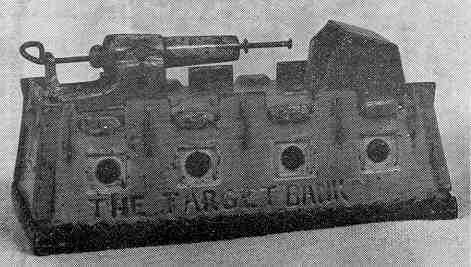Target Bank
by F.H. Griffith - HOBBIES Magazine - October, 1957

Cannons and guns as a toy item have always had popular appeal to boys. In the field of mechanical banks there is a select group of the cannon type bank and this would logically seem as though it should have been a popular group and thus more or less easily available to the mechanical bank collector of today. This, however, for some reason is not the case as the only mechanical bank in this group that is somewhat common is the Artillery Bank. All the others are quite scarce and rather hard to find. A fine example of this interesting group is the Target Bank, our choice as No. 58 in the numerical classification of the mechanical banks.
The Target Bank was patented March 20, 1877 by Louis C. Hoffmeister of Philadelphia, Pa., and one half his right was assigned to H. M. Beidler, also of Philadelphia. The action of the bank, which is rather unique, is well covered in the patent papers as is the unusual feature of two coin slots for the admission of small and large coins. The actual manufacturer of the bank, to the best of the writer’s knowledge, is unknown. The writer has never seen any old catalogs or similar material referring to or picturing the bank. Also, unfortunately, there are no markings or distinctive features that are indicative of any particular manufacturer. Beidler may have been connected with some concern who made the bank, however, this possibility has not been established one way or the other.
The specimen pictured is from the fine collection of Mr. L.C. Hegarty. It was found in the Duncansville-Hollidaysburg section of Pennsylvania. The bank is in nice original condition, however, the target part is missing. This part was originally located in front of the cannon. It fit into the front of what Hoffmeister in his patent papers referred to as the "house." This target was like a conventional target with circular rings, however, a coin slot ran horizontally across the face at the center. In addition the target was so located in the house that a semi-circular rest was formed in front of the target and this provided for larger coins to rest against the target. An aperture was located in front of the target for the entrance of coins used in this manner. Thus the target itself provided two coin slots, one in the center for small coins and one in front for larger coins.
To operate the bank the firing rod, which runs through the barrel of the cannon, is pulled back into the position shown in the picture. A coin, according to the size, is then placed horizontally in the target or in front of the target. Upon releasing the catch at the end of the carriage the rod springs forward striking the coin, shooting it through the target into the house from whence it drops into the bank. This action is with the smaller coins. When using larger coins the rod strikes the flat surface of the coin pushing it against the target and the coin then drops into the bank
The bank is attractively painted. The sides of the fort are gray with red edging, the bottom base and the house are blue. The cannon barrel is gray and the carriage is red. The name, "The Target Bank," appears on the side as shown in the picture.
The Target Bank is somewhat similar to Hold The Fort and it is interesting to note that both banks were patented in the same year. However, the mechanism and operation of each bank is quite different. Very few of the Target Banks have turned up so far and it is another difficult item to add to a collection.
